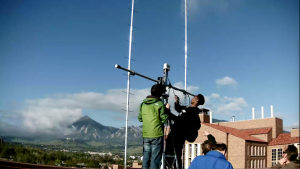New power amp and first big particle hit
We’ve been noodling with the ground station a lot these last 3 weeks since MinXSS has been deployed. We’re still running with just 1 of those 2 antennas you can see in the photo. That basically means that our beamwidth is a wider. We’ll be fixing the second antenna later this week.
But there has been one major improvement: we replaced the 100 W power amp with a 550 W one. That means our command uplink transmission power is significantly stronger. It’s strong enough that we can now reliably get commands into the system. Before, we got about 2 out of every 100 commands we sent through. So it was slow going. Now we get > 90% of them through.
The other big news is that one of the electronics components in the spacecraft got hit by an energetic particle and caused some problems. In aerospace lingo, these are referred to as “single event upsets”. The electronics component that was hit was one of the chips for measuring voltages/currents or temperatures. We’re not sure precisely which one, but it caused the communications bus where nearly all of those measurements are made to hang up. We tried soft-resetting the spacecraft, but the issue persisted. We developed a plan for operating in a mode where the flight software couldn’t read the battery voltage, a very important monitor. Turns out that the system did a full hard reboot, which cleared the issue. So now we’re actually in a better condition than we’ve ever been before, given the improved command uplink. We still have that plan prepared to deal with future single event upsets on the communications bus, should they occur. But now we know that the flight system can recover gracefully without intervention from the ground.
We should be done with commissioning by the end of the week!

